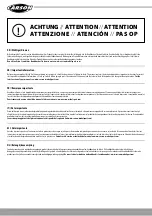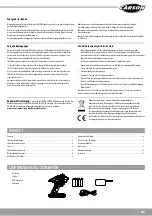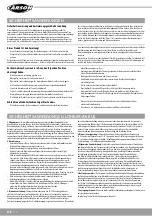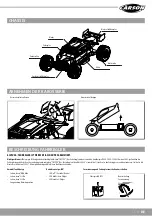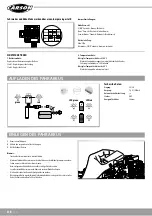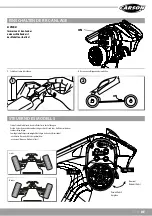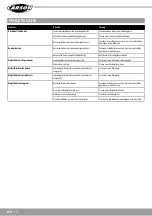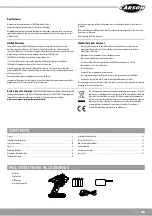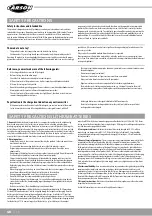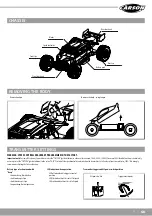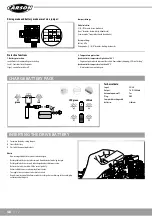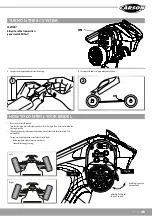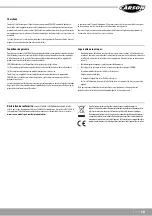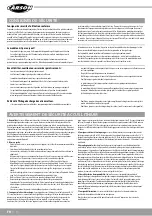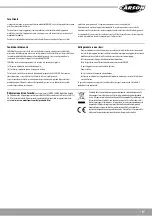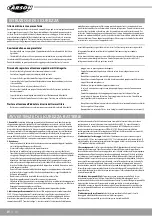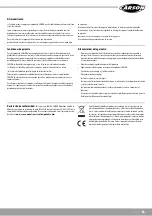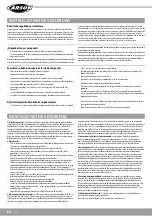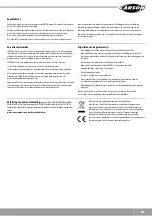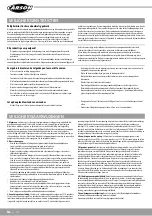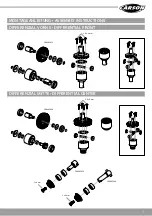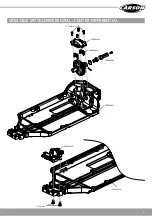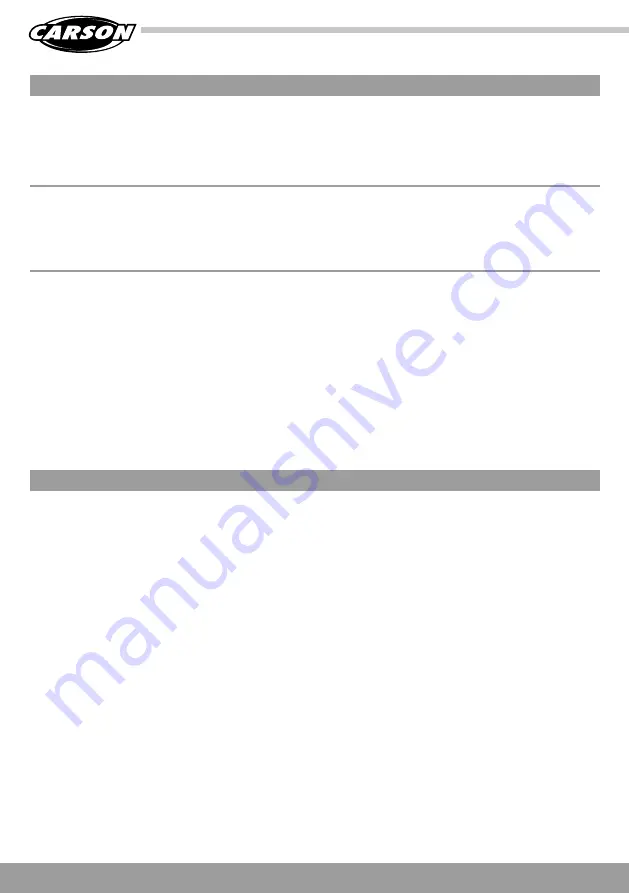
GB
// 10
Pay attention to the charge level indication on your transmitter.
• With power packs or batteries that are half discharged, you can lose control of the model.
• In the transmitter, never mix fully charged batteries, rechargeable or not, with half
discharged batteries or rechargeable batteries of different capacity.
• Never try to charge non-rechargeable batteries (dry cells), only batteries specified as
rechargeable can be charged.
SAFETY PRECAUTIONS
Safety Instructions and Intended Use
This product is designed exclusively for hobby use and may only be used on tracks and areas
intended for this purpose. No persons or animals may be transported with this model. To avoid
operator errors, it is mandatory that the user manual is read before use! These models may
only be used with bodywork that is correctly fitted. When removing the bodywork, please note
that, during operation, certain parts can become very hot. Please note that various models
can generate very high noise levels and should, therefore, not be operated in your immediate
proximity. Please make sure, before every driving session, that the tank is correctly closed or
the power pack is correctly inserted. To avoid faulty operation of the control system causing the
model to run out of control, it must be checked that the transmitter and model batteries are in
good condition. It is essential to check that the model is correctly assembled both before and
after use; if need be, tighten nuts and bolts.
This model is not a toy!
• This product is not a toy, its operation must be learned step by step.
• Children under 14 years of age should operate the model only if supervised by an adult.
Operating RC models is a fascinating hobby that, however, must only be exercised with proper
precautions and care. Since the weight of this model is considerable and it can reach a very high
speed it can, if it runs out of control, cause significant damage and injury for which you, as the
operator, are liable.
Only a correctly assembled model will work and react as expected.
Never improvise with unsuitable materials but, when the need arises, use only original spare
parts. Even if the model is pre-assembled, all joints and fastenings should be checked for correct
seating and tightness.
Before use, you must make sure of the following points:
• All rechargeable batteries must be fully charged.
• Before starting, check the radio range.
• Check that the model reacts correctly to the control signals.
• All functional parts of the product are in a faultless condition and have been checked.
• All screw fastenings are firmly seated.
• Do not drive under high-voltage power lines or radio masts or with nearby thunderstorms!
• Atmospheric interference can influence the operation of your model.
• The electrical parts of the model are not water-tight. Do not, therefore, drive it in rain or
snow or through puddles or wet grass.
• The remote controlled model may be driven only on suitable areas and must not be used on
the public highway.
• Do not use near people or animals!
• Do not use it when tired or if your reactions are otherwise impaired.
• Always maintain direct visual contact with your model.
• Regular maintenance and care are required for firt class driving performance.
• The model has parts that become hot in operation, e.g. the top of the motor, the metal
gearbox, amongst many others. Touching these parts during operation can cause injury.
1. General:
Lithium batteries (accumulators) are energy storage devices with a high energy
density and can present risks. For this reason, particular care is needed when charging,
discharging, storing and handling. Read these instructions very carefully before first using the
battery. Do not fail to take note of the warning notices and instructions for use. Misuse can lead
to risks such as explosion, overheating or fire. Failure to observe the instructions for use leads to
early failure and other defects. The instructions should therefore be kept in a safe place and it is
essential that they are handed over to the second user if the batteries are passed on.
2. Warning notices:
• Avoid short-circuits. A short-circuit may well destroy the product. Cables and connections
must be well insulated.
• It is essential when connecting the battery to ensure that the polarity is correct.
• Original plug connectors and cables may not be cut off or changed - if need be, use an
adapter cable.
• Do not expose the battery to excessive heat or cold or to direct sunlight. Do not throw in the
fire. Do not place the battery in contact with water or other liquids.
• Charge the battery only with charging units intended for the purpose and always use the
balancer connection. It is only by using the balancer connection that optimum charging can
be ensured. If this connection is not used, charging is subject to the risks mentioned above.
Before charging, always first allow the battery to cool to ambient temperature. Never charge
while hot.
• When charging, place the battery on a non-flammable, heat-resistant support. There should
be no flammable or readily ignited objects in the vicinity of the battery.
• During charging or operation, never leave the battery unsupervised.
• Do not fail to keep to the recommended charge/discharge current.
• The battery casing must not be damaged. It is essential to avoid damage by sharp objects
such as knives or the like, from dropping, impact, bending etc. Damaged batteries may no
longer be used.
• Batteries are not toys. They should be kept away from children.
3. Charging instructions:
Lithium batteries are charged according to the CC-CV procedure.
CC stands for “constant current“, which is applied during the first phase of charging. Once the
battery reaches the maximum voltage configured in the charger, it switches to CV (constant
voltage) for the second phase of charging. The battery voltage no longer increases. The charging
current now falls continuously until the battery is fully charged. The maximum charging current
for the battery is 1C (C=nominal capacity of the battery, e.g. for a battery with a nominal
capacity of 2700 mA, the maximum charging current for the battery is 2700 mA (2.7 A)). Never
charge several batteries together from a single charger. Differing states of charge and capacities
can lead to overcharging and destruction.
4. Storage instructions:
Lithium batteries should be stored charged to 20-50 % of their
capacity and at a temperature of 15-18 °C. If the cell voltage falls below 3 V, they should be
recharged. Deep discharge and storage when discharged (call voltage <3 V) will render the
battery unusable.
5. General terms of guarantee:
There is a legal guarantee for production and material faults
as applicable at the time of dispatch. No liability is accepted for normal wear and tear. This
guarantee does not apply for defects attributable to improper use, inadequate maintenance,
third-party interference or mechanical damage. This applies, in particular, to used batteries
and batteries clearly showing signs of use. Damage and loss of performance due to improper
handling and/or overload are not product faults. Batteries are consumables and subject to a
certain ageing. This is influenced by factors such as the charge/discharge currents, the charging
procedure, the operating and storage temperatures and the state of charge during storage.
The ageing shows itself in, among other things, an irreversible loss of capacity. In the model
field, where batteries are frequently used to supply motors, very high currents can flow from
time to time.
6. Exclusion of liability:
Since we are unable to have any control over charge/discharge, handling,
compliance with assembly and operating instructions, battery replacement and its care and
maintenance, Tamiya / Carson can accept no liability for loss, damage or costs incurred. Any claim
for damages that may result from operation, failure or faulty operation or that is in any way related
thereto will therefore be refused. We accept no liability for personal injury or material damage and
their consequences that arise from our delivery.
7. Disposal instructions:
Batteries are hazardous waste. Damaged or unusable cells must be
disposed of in the correct manner.
No liability for printing errors, we reserve the right to make changes!
SAFETY PRECAUTIONS LITHIUM BATTERIES
Summary of Contents for Climb Warrior 3.0
Page 24: ...24 CHASSIS CHASSIS 500405484 500405658 500405344 3 x 10 mm 3 x 10 mm ...
Page 27: ...27 3 x 5 mm 500405350 500405420 3 x 5 mm 500405350 500405344 3 x 10 mm ...
Page 28: ...28 500405656 500405656 500405656 500405651 500405653 500405653 500405653 ...
Page 29: ...29 SERVOSAVER SERVOSAVER 3 x 10 mm 500405660 500405660 500405360 500405360 3 x 10 mm ...
Page 34: ...34 MONTAGE AKKUHALTERUNG ASSEMBLING BATTERYMOUNT 500405662 500405658 500405658 ...
Page 35: ...35 MONTAGE ÜBERROLLKÄFIG ASSEMBLING ROLLOVER CAGE ...
Page 36: ...36 ...
Page 37: ...37 MONTAGE STOSSDÄMPFER ASSEMBLING SHOCK ABSORBERS ...
Page 39: ...39 MONTAGE RÄDER ASSEMBLING WHEELS 500900170 500900170 500405357 ...
Page 40: ...40 MONTAGE SPOILER ASSEMBLING WING 3 x 10 mm 500405496 ...


